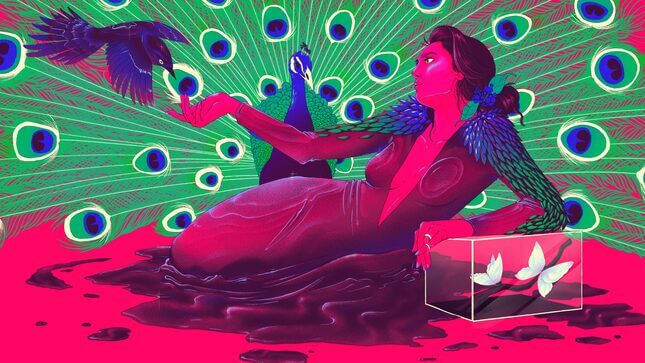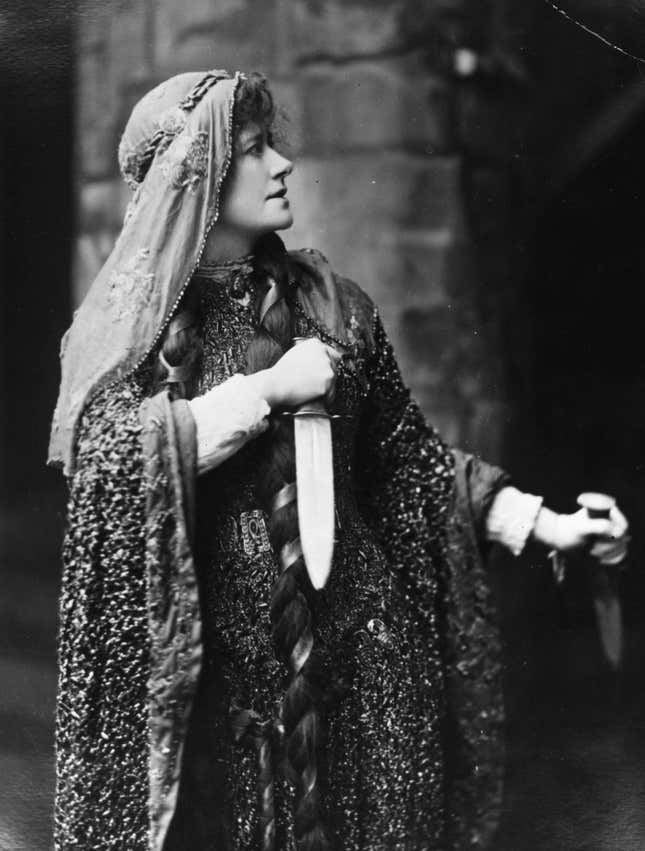From Victorians to Ravers: The Lustrous Magic of Iridescence in Fashion
In Depth
Illustration: Chelsea Beck
Ellen Terry wanted to look like a snake. She wanted her body to glimmer on stage, hard and soft at once, as though she were wearing the finest chainmail, the lightest armor. She was going to play Lady Macbeth, and Terry could be fussy about what she wore onstage. Not because she was vain, but because she understood both Shakespeare and the needs of her body; she knew instinctively, for instance, that Ophelia had to wear pink at the start of the show, and pale gold for the nunnery scene. She also knew she needed freedom of movement if she were to act properly; she had to be comfortable to embody her characters, to convince the audience. So she requested an iridescent dress, green and blue, fine and light, supple and strange.
Alice Comyns Carr, Terry’s costumer, didn’t disappoint. For Terry’s 1888 turn in The Scottish Play, she designed an emerald green gown with long, trailing bell-shaped sleeves, a high neckline, and over 1,000 beetle wings sewn onto the soft woven fabric. Dressmaker Ada Nettleship was responsible for bringing Terry and Carr’s joint vision to life (though it’s possible Nettleship was responsible for the beetle wing idea, since she had worked with this particular material before). When the show opened at Lyceum Theatre on December 31, painter John Singer Sargent was so struck by this version of the actress that he reached out and invited her to sit for a portrait in full costume. She arrived at his studio dressed the part, and Oscar Wilde (who was apparently on hand to comment) remarked, “The street that on a wet and dreary morning has vouchsafed the vision of Lady Macbeth in full regalia magnificently seated in a four-wheeler can never again be as other streets: it must always be full of wonderful possibilities.”

The dress now belongs to the National Trust and is housed at Smallhythe Place in Kent. You can see pictures of it online, but they’re disappointing. They don’t look as good as Sargent’s painting, which captures the glamor and romance of her body, that fabric, the thousand tiny wings. It dances like the northern lights. And like the aurora, the gown just doesn’t photograph very well. Like all iridescent things, it looks best when you can see how light plays over the surface of the cloth. When you freeze it, some of the wonder is lost. Possibilities are narrowed to a single point of view, a single focus. The colors become dull and lifeless, a drab olive green rather than a beguiling and impossible mixture of blue, green, red, orange, white.
This is, I think, what makes iridescent things so much more beguiling than objects that are simply shiny. Most shiny things (including metals like gold or silver) give off a gleam that can be named with one color word. But iridescent things reflect the whole range of colors; they give you a prismatic effect, a rainbow. A puddle is shiny. A bubble is iridescent. A silver ring is shiny. An opal is iridescent. They have luster. They have magic.
-

-

-

-

-

-

-

-

-

-

-

-

-

-

-

-

-

-

-

-

-

-

-

-

-

-

-

-

-

-

-

-

-

-

-

-

-

-

-

-










































